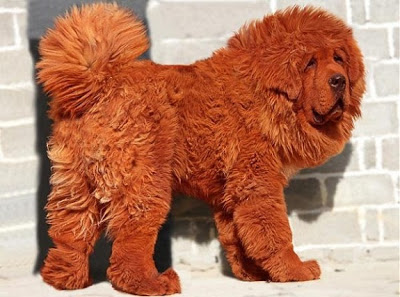Appearance of world most expensive dog Tibetan Mastiff :-
Currently,
some breeders differentiate between two "types" of Tibetan Mastiff,
the Do-khyi and the Tsang-khyi. The Tsang-khyi (which, to a Tibetan, means only
"dog from Tsang") is also referred to as the "monastery"
type, described as generally taller, heavier, and more heavily boned, with more
facial wrinkling and haw than the Do-khyi or "nomad" type. Both types
are often produced in the same litter with the larger, heavier pups being more
rare.
Males can
reach heights up to 32 inches (81.28 cm) at the withers, although the standard
for the breed is typically in the 25- to 28-inch (61- to 72-cm) range. Dogs
bred in the West weigh between 105 lb (47.6272 kg) and 180 lb (82 kg)—although
dogs in the upper range are often overweight. The enormous dogs being produced
in some Western and some Chinese kennels would have "cost" too much
to keep fed to have been useful to nomads; and their questionable structure
would have made them less useful as livestock or property guardians.
The Tibetan
Mastiff is considered a primitive breed. It typically retains the hardiness
which would be required for it to survive in Tibet and the high-altitude
Himalayan range, including the northern part of Nepal, India and Bhutan.
Instinctive behaviors including canine pack behavior contributed to the
survival of the breed in harsh environments. It is one of the few primitive dog
breeds that retains a single estrus per year instead of two, even at much lower
altitudes and in much more temperate climates than its native climate. This
characteristic is also found in wild canids such as the wolf. Since its estrus
usually takes place during late fall, most Tibetan Mastiff puppies are born
between December and January.
Its double
coat is long, subject to climate, and found in a wide variety of colors,
including solid black, black and tan, various shades of "red" (from
pale gold to deep red) and bluish-gray (dilute black).
The coat of a
Tibetan Mastiff lacks the unpleasant "big-dog" smell that affects
many large breeds. The coat, whatever its length or color(s), should shed dirt
and odors. Although the dogs shed somewhat throughout the year, there is
generally one great "molt" in late winter or early spring and
sometimes another, lesser molt in the late summer or early fall. (Sterilization
of the dog or bitch may dramatically affect the coat as to texture, density,
and shedding pattern.)
Tibetan Mastiffs are shown under one standard in the
West, but separated by the Indian breed standard into two varieties: Lion Head
(smaller; exceptionally long hair from forehead to withers, creating a ruff or
mane) and Tiger Head (larger; shorter hair).
source link

















0 comments:
Post a Comment